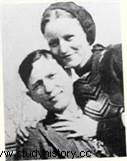 Bonnie Parker and Clyde Barrow , certainly the most famous criminal couple of the twentieth century, have inspired many artists, from Fritz Lang to Arthur Penn. The circumstances of their meeting are uncertain, perhaps as Clyde attempts to steal Bonnie's mother's vehicle. The latter leaves everything to share with Barrow a life of car thefts, bank robberies and murders. This headlong rush doomed to tragedy ended on May 23, 1934 in Black Lake, Louisiana in an ambush by the police. Bonnie and Clyde would later become symbols of a revolt against adult society and its moral and financial order.
Bonnie Parker and Clyde Barrow , certainly the most famous criminal couple of the twentieth century, have inspired many artists, from Fritz Lang to Arthur Penn. The circumstances of their meeting are uncertain, perhaps as Clyde attempts to steal Bonnie's mother's vehicle. The latter leaves everything to share with Barrow a life of car thefts, bank robberies and murders. This headlong rush doomed to tragedy ended on May 23, 1934 in Black Lake, Louisiana in an ambush by the police. Bonnie and Clyde would later become symbols of a revolt against adult society and its moral and financial order.
Bonnie and Clyde, a couple of criminals
Bonnie Parker was born in Rowena, Texas in 1910. From a modest background (and fatherless very early on) she nevertheless became a brilliant, eloquent student, passionate about poetry and gifted in public speaking. Married at 16 to a high school sweetheart, she separated from husband Roy Thornton (never divorcing) three years later. In 1930 at the home of a common acquaintance, she met the one who would remain the great love of her short life:Clyde Barrow, born in 1909 and also a Texan. Coming from an extremely modest background (affected by the rural exodus), he quickly descended into crime. Arrested in 1930 after several thefts and robberies, he committed his first murder in prison by smashing the skull of an inmate who had tried to sexually assault him.
 When he was released from prison in 1932, he once again engaged in illegal activities and mounted a gang of associates with the aid of his brother Buck. One of her first recruits is none other than Bonnie Parker, who has not forgotten her lover during her time in prison. The poet turns out of love into a hardened criminal. This is the beginning of a series of armed robberies and violent crimes, which quickly earns the Texan lovers a national reputation. Joined by another thug, Henry Methvin, the Barrow gang sinks into a bloody, infernal spiral, the outcome of which can only be fatal.
When he was released from prison in 1932, he once again engaged in illegal activities and mounted a gang of associates with the aid of his brother Buck. One of her first recruits is none other than Bonnie Parker, who has not forgotten her lover during her time in prison. The poet turns out of love into a hardened criminal. This is the beginning of a series of armed robberies and violent crimes, which quickly earns the Texan lovers a national reputation. Joined by another thug, Henry Methvin, the Barrow gang sinks into a bloody, infernal spiral, the outcome of which can only be fatal.
Tragic end for Bonnie Parker and Clyde Barrow
In 1933 Buck, Clyde's brother is shot dead by the police. A few months later in April 1934, the beleaguered couple shot dead two police officers in Texas. The American authorities, ridiculed by the press, then decide not to apprehend the terrible lovers but to kill them. The hunt is led by ex-Texas Ranger Frank Hamer, a local legend known to be inflexible and ruthless. Thanks to the collaboration of the police of five states (exceptional at the time) and what will become the FBI the following year, Hamer progresses rapidly. The hunt will finally lead to the ambush of May 23, 1934.
 Six police officers, led by Frank Hammer, positioned themselves at dawn on a small road on the outskirts of the small town of Bienville in Louisiana. The couple of assassins is supposed to go there to rob a bank, aboard a Ford V8. The tip turns out to be correct and the Barrows arrive at the ambush site. The heavily armed police opened fire, riddled the vehicle and its occupants with bullets. The latter die almost instantly without being able to retaliate. They will never challenge US authorities again.
Six police officers, led by Frank Hammer, positioned themselves at dawn on a small road on the outskirts of the small town of Bienville in Louisiana. The couple of assassins is supposed to go there to rob a bank, aboard a Ford V8. The tip turns out to be correct and the Barrows arrive at the ambush site. The heavily armed police opened fire, riddled the vehicle and its occupants with bullets. The latter die almost instantly without being able to retaliate. They will never challenge US authorities again.
The event, immortalized by numerous photographs and a 16 mm film, will make the couple one of the emblems of their time. Symbols despite themselves of the harshness of an era (that of the Great Depression), romantic figures of a love perceived as liberated, the mobster and the poetess will have generated a modern myth. A myth that would almost make you forget that the couple was responsible for a dozen murders...
To go further
- Les amants terribles, by Frédéric Perroud. Belfond, 1999.
- Bonnie and Clyde, by Arthur Penn, with Faye Dunaway and Warren Beatty. On DVD.
- The Highwaymen, fiction which tells the hunt for Franck Hammer.
